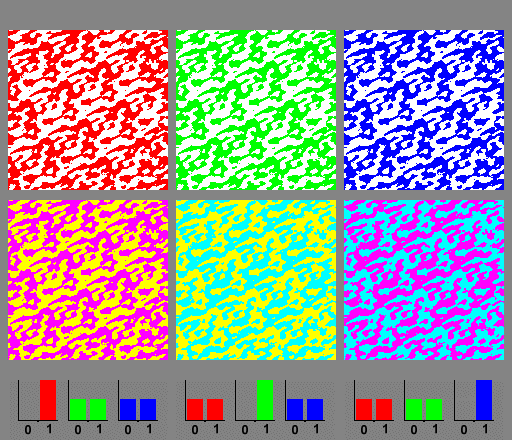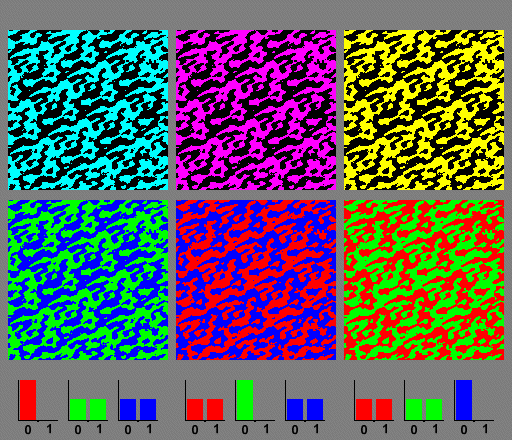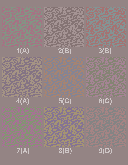|
|
|
Our Tech Examples Applications FAQ Index Sales
|

Color Information Loss From Independent Component Analysis
or, why color machine vision systems using some traditional approaches may have difficulty differentiating red and white capsules from magenta and yellow capsules.
We demonstrate here how loss of this critical information can lead to erroneous identification of even the simplest multicolored objects when systems rely on mean values or on individual analysis of the R, G, and B (or H, S, and I components).

 Each of these images shows three pairs of color patterns.
For simplicity the patterns contain only colors lying at the corners of the RGB color cube: red, green, blue, yellow, cyan, magenta, black, and white.
Each pattern consists of equal parts of two different colors with the colors of the upper member of a pair being very different from those of the lower. The upper pattern in the leftmost pair is half red and half white while the lower member is half magenta and half yellow.
Each of these images shows three pairs of color patterns.
For simplicity the patterns contain only colors lying at the corners of the RGB color cube: red, green, blue, yellow, cyan, magenta, black, and white.
Each pattern consists of equal parts of two different colors with the colors of the upper member of a pair being very different from those of the lower. The upper pattern in the leftmost pair is half red and half white while the lower member is half magenta and half yellow.
Below each pair of patterns are three histograms, one each for the red, green and blue components. The column indicated by "0" shows the relative number of pixels in which the component is absent, the column indicated by "1" shows the relative number of pixels in which the component is present. For the upper image of the first pair: 100 percent of the pixels have the red component present, 50 percent of the pixels have the green component present, and 50 percent of the pixels have the blue component present. Pixels which contain green also contain blue. Pixels which have all three components present appear as white, those with only the red component present appear of course as red. The mean color of the entire pattern is pink.
The lower pattern of the same pair is identical with the upper except that pixels which contain green do not contain blue and vice versa. The R, G, and B histograms are identical to those of the upper image, and again the mean color is pink. Therefore these statistics provide no useful information for differentiating the two patterns, and color machine vision systems relying on them are bound to have problems.
Exactly the same conditions apply to each of the other five pattern pairs: they cannot be distinguished by individual analysis of the R, G, and B histograms or the mean values. Note that the issue here is not the use of RGB space but the individual analysis of the R, G, and B components. Similar problems appear in HSI space, or any other space in which analysis is performed on a component by component basis.
If systems using these traditional color analysis methods cannot differentiate
such strikingly different color patterns, they are certain to have even more problems when color differences are more complex and/or more subtle.
 For example, consider the patterns in this image. Although relatively simple, they have many characteristics in common with
camouflage, upholstery fabrics, stone products, and other natural materials. Human inspectors with normal color vision can differentiate these patterns based on the entire pattern or any portion containing both colors of the pair. An automated recognition system should be able to do the same.
For example, consider the patterns in this image. Although relatively simple, they have many characteristics in common with
camouflage, upholstery fabrics, stone products, and other natural materials. Human inspectors with normal color vision can differentiate these patterns based on the entire pattern or any portion containing both colors of the pair. An automated recognition system should be able to do the same.
All of the color patterns and the background, have identical means and therefore they cannot be distinguished on the basis of this statistic. There are only four different R, G, and B histogram sets for the nine patterns. The specific histogram set associated with each pattern is indicated by one of the letters A-D. Note that patterns belonging to the same histogram set may appear quite dissimilar and conversely, patterns which appear more similar may be associated with different histogram sets. This clearly demonstrates how systems relying on analysis of multicolored images on a component by component basis can reach erroneous conclusions.
This does not mean that systems which analyse on a component by component basis can never differentiate multicolored objects. It only means that differentiation is much less reliable, more unpredictable, and will be limited to a tiny fraction of the color combinations which can be handled by systems, such as WAY-2C, which analyze the combined color distribution.